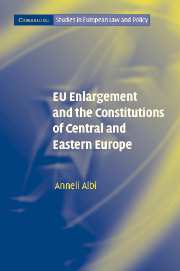Book contents
- Frontmatter
- Contents
- List of tables
- Series Editors' Preface
- Acknowledgements
- Table of cases
- Table of treaties, laws and other instruments
- List of abbreviations
- Introduction
- 1 Overview of the accession process
- 2 Constitutional adaptations in the ‘old’ Member States
- 3 Some idiosyncrasies of CEE constitutions
- 4 Constitutional issues in the pre-accession period
- 5 Revision of CEE constitutions for EU membership
- 6 Theoretical views of sovereignty and democratic legitimacy in CEE
- 7 Referendums
- 8 Membership of NATO and other international organisations
- 9 Role of Constitutional Courts
- 10 Implications of the European Constitution
- Epilogue: ‘Taking constitutions seriously’ in the process of European integration
- Bibliography
- Appendix
- Index
3 - Some idiosyncrasies of CEE constitutions
Published online by Cambridge University Press: 28 July 2009
- Frontmatter
- Contents
- List of tables
- Series Editors' Preface
- Acknowledgements
- Table of cases
- Table of treaties, laws and other instruments
- List of abbreviations
- Introduction
- 1 Overview of the accession process
- 2 Constitutional adaptations in the ‘old’ Member States
- 3 Some idiosyncrasies of CEE constitutions
- 4 Constitutional issues in the pre-accession period
- 5 Revision of CEE constitutions for EU membership
- 6 Theoretical views of sovereignty and democratic legitimacy in CEE
- 7 Referendums
- 8 Membership of NATO and other international organisations
- 9 Role of Constitutional Courts
- 10 Implications of the European Constitution
- Epilogue: ‘Taking constitutions seriously’ in the process of European integration
- Bibliography
- Appendix
- Index
Summary
Constitutional history of CEE countries
Before exploring the adaptation of CEE constitutions for EU membership, it is instructive to outline the constitutional background of these countries, in order to better understand some characteristic features of their constitutions. In broad outline, the constitutional history of the ten Central and East European countries could be divided into four major periods:
the adoption of the first constitutions in most countries as a result of establishing independent republics between the two World Wars;
the putting into place of the Communist constitutions in the aftermath of the Soviet takeover in the 1940s;
the adoption of the new constitutions or comprehensive revision of the Communist constitutions after the regime change in the early 1990s;
and
subsequent constitutional adjustments, including the ‘opening up’ of the constitutions for transfer of powers to international organisations and to the EU.
Amongst the countries in question, Poland, Bulgaria and Romania have long-standing traditions of statehood and constitutions. In fact, Poland was the first country in Europe, and the second in the world, to adopt a constitution in 1791. Bulgaria and Romania adopted their first constitutions respectively in 1879 and 1866, having gained their independence from the Ottoman Empire. In other CEE countries, the constitutional history commenced with gaining independence in 1918, as a result of the Versailles Peace Conference following the First World War: Czechoslovakia and Hungary emerged from the dissolution of the Habsburg Empire, while the Baltic countries separated from Russia.
- Type
- Chapter
- Information
- Publisher: Cambridge University PressPrint publication year: 2005



